Trade-Offs and Synergies of Ecosystem Services in Terminal Lake Basins of Arid Regions Under Environmental Change: A Case Study of the Ebinur Lake Basin
Abstract
1. Introduction
2. Materials and Methods
2.1. Study Area
2.2. Data Sources
2.3. Methods
2.3.1. Assessment of Landscape Pattern Changes
2.3.2. Ecosystem Services Assessment
2.3.3. Trend Analysis of Ecosystem Services
2.3.4. Standardization of Ecosystem Services
2.3.5. Comprehensive Benefits of Ecosystem Services
2.3.6. Trade-Offs and Synergies of Ecosystem Services
2.3.7. Analysis of Factors Influencing Ecosystem Services
3. Results
3.1. Spatiotemporal Changes in Landscape Patterns
3.2. Spatiotemporal Changes in Ecosystem Services
3.3. Assessment of Comprehensive Ecosystem Service Benefits
3.4. Trade-Offs and Synergies Among Ecosystem Services
4. Discussion
4.1. Influence of Natural Factors on Landscape Patterns
4.2. Influence of Anthropogenic Factors on Landscape Patterns
4.3. Influence of Natural Factors on Ecosystem Services
4.4. Influence of Anthropogenic Factors on Ecosystem Services
4.5. Prospects and Limitations
5. Conclusions
Author Contributions
Funding
Data Availability Statement
Acknowledgments
Conflicts of Interest
References
- Danley, B.; Widmark, C. Evaluating conceptual definitions of ecosystem services and their implications. Ecol. Econ. 2016, 126, 132–138. [Google Scholar] [CrossRef]
- Hernández-Blanco, M.; Costanza, R.; Chen, H.; DeGroot, D.; Jarvis, D.; Kubiszewski, I.; Montoya, J.; Sangha, K.; Stoeckl, N.; Turner, K. Ecosystem health, ecosystem services, and the well-being of humans and the rest of nature. Glob. Change Biol. 2022, 28, 5027–5040. [Google Scholar] [CrossRef] [PubMed]
- Schirpke, U.; Wang, G.; Padoa-Schioppa, E. Mountain landscapes: Protected areas, ecosystem services, and future challenges. Ecosyst. Serv. 2021, 49, 101302. [Google Scholar] [CrossRef]
- Fang, Z.; Ding, T.; Chen, J.; Xue, S.; Zhou, Q.; Wang, Y.; Wang, Y.; Huang, Z.; Yang, S. Impacts of land use/land cover changes on ecosystem services in ecologically fragile regions. Sci. Total Environ. 2022, 831, 154967. [Google Scholar] [CrossRef]
- Hernández, R.C.; Camerin, F. The application of ecosystem assessments in land use planning: A case study for supporting decisions toward ecosystem protection. Futures 2024, 161, 103399. [Google Scholar] [CrossRef]
- Allan, J.I.; Auld, G.; Cadman, T.; Stevenson, H. Comparative fortunes of ecosystem services as an international governance concept. Glob. Policy 2022, 13, 62–75. [Google Scholar] [CrossRef]
- Peng, K.; Jiang, W.; Ling, Z.; Hou, P.; Deng, Y. Evaluating the potential impacts of land use changes on ecosystem service value under multiple scenarios in support of SDG reporting: A case study of the Wuhan urban agglomeration. J. Clean. Prod. 2021, 307, 127321. [Google Scholar] [CrossRef]
- Zhang, H.; Zhang, Z.; Liu, K.; Huang, C.; Dong, G. Integrating land use management with trade-offs between ecosystem services: A framework and application. Ecol. Indic. 2023, 149, 110193. [Google Scholar] [CrossRef]
- Wang, H.; Zhou, S.; Li, X.; Liu, H.; Chi, D.; Xu, K. The influence of climate change and human activities on ecosystem service value. Ecol. Eng. 2016, 87, 224–239. [Google Scholar] [CrossRef]
- Wang, J.; Wu, W.; Yang, M.; Gao, Y.; Shao, J.; Yang, W.; Ma, G.; Yu, F.; Yao, N.; Jiang, H. Exploring the complex trade-offs and synergies of global ecosystem services. Environ. Sci. Ecotechnol. 2024, 21, 100391. [Google Scholar] [CrossRef]
- Bai, Y.; Zhuang, C.; Ouyang, Z.; Zheng, H.; Jiang, B. Spatial characteristics between biodiversity and ecosystem services in a human-dominated watershed. Ecol. Complex. 2011, 8, 177–183. [Google Scholar] [CrossRef]
- Li, B.; Wang, W. Trade-offs and synergies in ecosystem services for the Yinchuan Basin in China. Ecol. Indic. 2018, 84, 837–846. [Google Scholar] [CrossRef]
- Bennett, E.M.; Peterson, G.D.; Gordon, L.J. Understanding relationships among multiple ecosystem services. Ecol. Lett. 2009, 12, 1394–1404. [Google Scholar] [CrossRef] [PubMed]
- Troell, M.; Costa-Pierce, B.; Stead, S.; Cottrell, R.S.; Brugere, C.; Farmery, A.K.; Little, D.C.; Strand, Å.; Pullin, R.; Soto, D. Perspectives on aquaculture’s contribution to the Sustainable Development Goals for improved human and planetary health. J. World Aquac. Soc. 2023, 54, 251–342. [Google Scholar] [CrossRef]
- Xia, H.; Yuan, S.; Prishchepov, A.V. Spatial-temporal heterogeneity of ecosystem service interactions and their social-ecological drivers: Implications for spatial planning and management. Resour. Conserv. Recycl. 2023, 189, 106767. [Google Scholar] [CrossRef]
- Wang, B.; Zhang, Q.; Cui, F. Scientific research on ecosystem services and human well-being: A bibliometric analysis. Ecol. Indic. 2021, 125, 107449. [Google Scholar] [CrossRef]
- Zeng, J.; Xu, J.; Li, W.; Dai, X.; Zhou, J.; Shan, Y.; Zhang, J.; Li, W.; Lu, H.; Ye, Y. Evaluating trade-off and synergies of ecosystem services values of a representative resources-based urban ecosystem: A coupled modeling framework applied to Panzhihua City, China. Remote Sens. 2022, 14, 5282. [Google Scholar] [CrossRef]
- Wanghe, K.; Guo, X.; Ahmad, S.; Tian, F.; Nabi, G.; Strelnikov, I.I.; Li, K.; Zhao, K. FRESF model: An ArcGIS toolbox for rapid assessment of the supply, demand, and flow of flood regulation ecosystem services. Ecol. Indic. 2022, 143, 109264. [Google Scholar] [CrossRef]
- Uniyal, B.; Kosatica, E.; Koellner, T. Spatial and temporal variability of climate change impacts on ecosystem services in small agricultural catchments using the Soil and Water Assessment Tool (SWAT). Sci. Total Environ. 2023, 875, 162520. [Google Scholar] [CrossRef]
- Zhao, L.; Yu, W.; Meng, P.; Zhang, J.; Zhang, J. InVEST model analysis of the impacts of land use change on landscape pattern and habitat quality in the Xiaolangdi Reservoir area of the Yellow River basin, China. Land Degrad. Dev. 2022, 33, 2870–2884. [Google Scholar] [CrossRef]
- Zafar, Z.; Zubair, M.; Zha, Y.; Mehmood, M.S.; Rehman, A.; Fahd, S.; Nadeem, A.A. Predictive modeling of regional carbon storage dynamics in response to land use/land cover changes: An InVEST-based analysis. Ecol. Inform. 2024, 82, 102701. [Google Scholar] [CrossRef]
- Zhang, Y.; Guan, D.; Wu, L.; Su, X.; Zhou, L.; Peng, G. How can an ecological compensation threshold be determined? A discriminant model integrating the minimum data approach and the most appropriate land use scenarios. Sci. Total Environ. 2022, 852, 158377. [Google Scholar] [CrossRef]
- Nguyen, T.T.; Grote, U.; Neubacher, F.; Do, M.H.; Paudel, G.P. Security risks from climate change and environmental degradation: Implications for sustainable land use transformation in the Global South. Curr. Opin. Environ. Sustain. 2023, 63, 101322. [Google Scholar] [CrossRef]
- Terrado, M.; Sabater, S.; Chaplin-Kramer, B.; Mandle, L.; Ziv, G.; Acuña, V. Model development for the assessment of terrestrial and aquatic habitat quality in conservation planning. Sci. Total Environ. 2016, 540, 63–70. [Google Scholar] [CrossRef]
- Martinez-Harms, M.J.; Bryan, B.A.; Balvanera, P.; Law, E.A.; Rhodes, J.R.; Possingham, H.P.; Wilson, K.A. Making decisions for managing ecosystem services. Biol. Conserv. 2015, 184, 229–238. [Google Scholar] [CrossRef]
- Wong, C.P.; Jiang, B.; Kinzig, A.P.; Lee, K.N.; Ouyang, Z. Linking ecosystem characteristics to final ecosystem services for public policy. Ecol. Lett. 2015, 18, 108–118. [Google Scholar] [CrossRef]
- Yue, L.; Shi, Q.; Jingjing, L. Research on ecological restoration technology in arid or semi-arid areas from the perspective of the Belt and Road Initiative. J. Resour. Ecol. 2022, 13, 964–976. [Google Scholar] [CrossRef]
- Chen, X.; Wang, Y.; Pei, H.; Guo, Y.; Zhang, J.; Shen, Y. Expansion of irrigation led to inland lake shrinking in semi-arid agro-pastoral region, China: A case study of Chahannur Lake. J. Hydrol. Reg. Stud. 2022, 41, 101086. [Google Scholar] [CrossRef]
- Guo, C.; Gao, J.; Zhou, B.; Yang, J. Factors of the ecosystem service value in water conservation areas considering the natural environment and human activities: A case study of Funiu mountain, China. Int. J. Environ. Res. Public Health 2021, 18, 11074. [Google Scholar] [CrossRef]
- Fischer, G.; Tubiello, F.N.; Van Velthuizen, H.; Wiberg, D.A. Climate change impacts on irrigation water requirements: Effects of mitigation, 1990–2080. Technol. Forecast. Soc. Change 2007, 74, 1083–1107. [Google Scholar] [CrossRef]
- Alizadeh-Choobari, O.; Ahmadi-Givi, F.; Mirzaei, N.; Owlad, E. Climate change and anthropogenic impacts on the rapid shrinkage of Lake Urmia. Int. J. Climatol. 2016, 36, 4276–4286. [Google Scholar] [CrossRef]
- Xu, J.; Wang, Y.; Teng, M.; Wang, P.; Yan, Z.; Wang, H. Ecosystem services of lake-wetlands exhibit significant spatiotemporal heterogeneity and scale effects in a multi-lake megacity. Ecol. Indic. 2023, 154, 110843. [Google Scholar] [CrossRef]
- Davis, M.D. Integrated water resource management and water sharing. J. Water Resour. Plan. Manag. 2007, 133, 427–445. [Google Scholar] [CrossRef]
- Haddad, N.M.; Brudvig, L.A.; Clobert, J.; Davies, K.F.; Gonzalez, A.; Holt, R.D.; Lovejoy, T.E.; Sexton, J.O.; Austin, M.P.; Collins, C.D. Habitat fragmentation and its lasting impact on Earth’s ecosystems. Sci. Adv. 2015, 1, e1500052. [Google Scholar] [CrossRef] [PubMed]
- Dobson, A.; Lodge, D.; Alder, J.; Cumming, G.S.; Keymer, J.; McGlade, J.; Mooney, H.; Rusak, J.A.; Sala, O.; Wolters, V. Habitat loss, trophic collapse, and the decline of ecosystem services. Ecology 2006, 87, 1915–1924. [Google Scholar] [CrossRef]
- Luo, C.; Ma, X.; Yan, W.; Wang, Y. Trade-Offs and Optimization of Ecosystem Services in the Plain Terminal Lake Basin: A Case Study of Xinjiang. Land Degrad. Dev. 2024, 35, 5043–5061. [Google Scholar] [CrossRef]
- Shen, Z.; Wu, W.; Tian, S.; Wang, J. A multi-scale analysis framework of different methods used in establishing ecological networks. Landsc. Urban Plan. 2022, 228, 104579. [Google Scholar] [CrossRef]
- Andrew, M.E.; Wulder, M.A.; Nelson, T.A. Potential contributions of remote sensing to ecosystem service assessments. Prog. Phys. Geogr. 2014, 38, 328–353. [Google Scholar] [CrossRef]
- Foroumandi, E.; Nourani, V.; Kantoush, S.A. Investigating the main reasons for the tragedy of large saline lakes: Drought, climate change, or anthropogenic activities? A call to action. J. Arid Environ. 2022, 196, 104652. [Google Scholar] [CrossRef]
- Zhang, X.; Li, Y.; Ren, S.; Zhang, X. Soil CO2 emissions and water level response in an arid zone lake wetland under freeze–thaw action. J. Hydrol. 2023, 625, 130069. [Google Scholar] [CrossRef]
- Qian, Y.; Wu, Z.; Zhang, L.; Zhou, H.; Wu, S.; Yang, Q. Eco-environmental evolution, control, and adjustment for Aibi Lake catchment. Environ. Manag. 2005, 36, 506–517. [Google Scholar] [CrossRef] [PubMed]
- Srivastav, A.L.; Dhyani, R.; Ranjan, M.; Madhav, S.; Sillanpää, M. Climate-resilient strategies for sustainable management of water resources and agriculture. Environ. Sci. Pollut. Res. 2021, 28, 41576–41595. [Google Scholar] [CrossRef]
- Pan, L.; Li, G.; Chen, C.; Liu, Y.; Lai, J.; Yang, J.; Jin, M.; Wang, Z.; Wang, X.; Ding, W. Late Holocene decoupling of lake and vegetation ecosystem in response to centennial-millennial climatic changes in arid Central Asia: A case study from Aibi Lake of western Junggar Basin. Palaeogeogr. Palaeoclimatol. Palaeoecol. 2024, 646, 112233. [Google Scholar] [CrossRef]
- Rhodes, T.E.; Gasse, F.; Lin, R.; Fontes, J.-C.; Wei, K.; Bertrand, P.; Gibert, E.; Mélières, F.; Tucholka, P.; Wang, Z. A late pleistocene-Holocene lacustrine record from Lake Manas, Zunggar (northern Xinjiang, western China). Palaeogeogr. Palaeoclimatol. Palaeoecol. 1996, 120, 105–121. [Google Scholar] [CrossRef]
- Zhaoyong, Z.; Xiaodong, Y.; Shengtian, Y. Heavy metal pollution assessment, source identification, and health risk evaluation in Aibi Lake of northwest China. Environ. Monit. Assess. 2018, 190, 1–13. [Google Scholar] [CrossRef] [PubMed]
- Yao, J.; Mao, W.; Chen, J.; Dilinuer, T. Recent signal and impact of wet-to-dry climatic shift in Xinjiang, China. J. Geogr. Sci. 2021, 31, 1283–1298. [Google Scholar] [CrossRef]
- Abahussain, A.A.; Abdu, A.S.; Al-Zubari, W.K.; El-Deen, N.A.; Abdul-Raheem, M. Desertification in the Arab Region: Analysis of current status and trends. J. Arid Environ. 2002, 51, 521–545. [Google Scholar] [CrossRef]
- Alifujiang, Y.; Abuduwaili, J.; Ma, L.; Samat, A.; Groll, M. System dynamics modeling of water level variations of Lake Issyk-Kul, Kyrgyzstan. Water 2017, 9, 989. [Google Scholar] [CrossRef]
- Zhao, Q.; Wen, Z.; Chen, S.; Ding, S.; Zhang, M. Quantifying land use/land cover and landscape pattern changes and impacts on ecosystem services. Int. J. Environ. Res. Public Health 2020, 17, 126. [Google Scholar] [CrossRef]
- Peng, J.; Wang, Y.; Zhang, Y.; Wu, J.; Li, W.; Li, Y. Evaluating the effectiveness of landscape metrics in quantifying spatial patterns. Ecol. Indic. 2010, 10, 217–223. [Google Scholar] [CrossRef]
- Plexida, S.G.; Sfougaris, A.I.; Ispikoudis, I.P.; Papanastasis, V.P. Selecting landscape metrics as indicators of spatial heterogeneity—A comparison among Greek landscapes. Int. J. Appl. Earth Obs. Geoinf. 2014, 26, 26–35. [Google Scholar] [CrossRef]
- Chust, G.; Ducrot, D.; Pretus, J.L. Land cover mapping with patch-derived landscape indices. Landsc. Urban Plan. 2004, 69, 437–449. [Google Scholar] [CrossRef]
- Guo, S.; Wu, C.; Wang, Y.; Qiu, G.; Zhu, D.; Niu, Q.; Qin, L. Threshold effect of ecosystem services in response to climate change, human activity and landscape pattern in the upper and middle Yellow River of China. Ecol. Indic. 2022, 136, 108603. [Google Scholar] [CrossRef]
- Hargis, C.D.; Bissonette, J.A.; David, J.L. The behavior of landscape metrics commonly used in the study of habitat fragmentation. Landsc. Ecol. 1998, 13, 167–186. [Google Scholar] [CrossRef]
- Ahmadi Mirghaed, F.; Souri, B. Effect of landscape fragmentation on soil quality and ecosystem services in land use and landform types. Environ. Earth Sci. 2022, 81, 330. [Google Scholar] [CrossRef]
- Zhang, Q.; Chen, C.; Wang, J.; Yang, D.; Zhang, Y.; Wang, Z.; Gao, M. The spatial granularity effect, changing landscape patterns, and suitable landscape metrics in the Three Gorges Reservoir Area, 1995–2015. Ecol. Indic. 2020, 114, 106259. [Google Scholar] [CrossRef]
- Li, B.-L. Fractal geometry applications in description and analysis of patch patterns and patch dynamics. Ecol. Model. 2000, 132, 33–50. [Google Scholar] [CrossRef]
- Jackson, B.; Pagella, T.; Sinclair, F.; Orellana, B.; Henshaw, A.; Reynolds, B.; Mcintyre, N.; Wheater, H.; Eycott, A. Polyscape: A GIS mapping framework providing efficient and spatially explicit landscape-scale valuation of multiple ecosystem services. Landsc. Urban Plan. 2013, 112, 74–88. [Google Scholar] [CrossRef]
- Feld, C.K.; Martins da Silva, P.; Paulo Sousa, J.; De Bello, F.; Bugter, R.; Grandin, U.; Hering, D.; Lavorel, S.; Mountford, O.; Pardo, I. Indicators of biodiversity and ecosystem services: A synthesis across ecosystems and spatial scales. Oikos 2009, 118, 1862–1871. [Google Scholar] [CrossRef]
- Dong, J.; Guo, Z.; Zhao, Y.; Hu, M.; Li, J. Coupling coordination analysis of industrial mining land, landscape pattern and carbon storage in a mining city: A case study of Ordos, China. Geomat. Nat. Hazards Risk 2023, 14, 2275539. [Google Scholar] [CrossRef]
- Ali, S.; Khan, S.M.; Ahmad, Z.; Siddiq, Z.; Ullah, A.; Yoo, S.; Han, H.; Raposo, A. Carbon sequestration potential of different forest types in Pakistan and its role in regulating services for public health. Front. Public Health 2023, 10, 1064586. [Google Scholar] [CrossRef] [PubMed]
- Baixue, W.; Weiming, C.; Shengxin, L. Impact of land use changes on habitat quality in Altay region. J. Resour. Ecol. 2021, 12, 715–728. [Google Scholar] [CrossRef]
- Ma, S.; Qiao, Y.-P.; Wang, L.-J.; Zhang, J.-C. Terrain gradient variations in ecosystem services of different vegetation types in mountainous regions: Vegetation resource conservation and sustainable development. For. Ecol. Manag. 2021, 482, 118856. [Google Scholar] [CrossRef]
- Verdonschot, P.; Verdonschot, R. The role of stream restoration in enhancing ecosystem services. Hydrobiologia 2023, 850, 2537–2562. [Google Scholar] [CrossRef]
- Del Serrone, G.; Moretti, L. A stepwise regression to identify relevant variables affecting the environmental impacts of clinker production. J. Clean. Prod. 2023, 398, 136564. [Google Scholar] [CrossRef]
- Liao, Q.; Li, T.; Wang, Q.; Liu, D. Exploring the ecosystem services bundles and influencing drivers at different scales in southern Jiangxi, China. Ecol. Indic. 2023, 148, 110089. [Google Scholar] [CrossRef]
- Zheng, D.; Wang, Y.; Hao, S.; Xu, W.; Lv, L.; Yu, S. Spatial-temporal variation and tradeoffs/synergies analysis on multiple ecosystem services: A case study in the Three-River Headwaters region of China. Ecol. Indic. 2020, 116, 106494. [Google Scholar] [CrossRef]
- Lee, H.; Lautenbach, S. A quantitative review of relationships between ecosystem services. Ecol. Indic. 2016, 66, 340–351. [Google Scholar] [CrossRef]
- Su, S.; Li, D.; Hu, Y.n.; Xiao, R.; Zhang, Y. Spatially non-stationary response of ecosystem service value changes to urbanization in Shanghai, China. Ecol. Indic. 2014, 45, 332–339. [Google Scholar] [CrossRef]
- Gustafson, E.J. Quantifying landscape spatial pattern: What is the state of the art? Ecosystems 1998, 1, 143–156. [Google Scholar] [CrossRef]
- Lausch, A.; Blaschke, T.; Haase, D.; Herzog, F.; Syrbe, R.-U.; Tischendorf, L.; Walz, U. Understanding and quantifying landscape structure–A review on relevant process characteristics, data models and landscape metrics. Ecol. Model. 2015, 295, 31–41. [Google Scholar] [CrossRef]
- Stephens, C.M.; Lall, U.; Johnson, F.; Marshall, L.A. Landscape changes and their hydrologic effects: Interactions and feedbacks across scales. Earth-Sci. Rev. 2021, 212, 103466. [Google Scholar] [CrossRef]
- McGuire, J.L.; Lawler, J.J.; McRae, B.H.; Nuñez, T.A.; Theobald, D.M. Achieving climate connectivity in a fragmented landscape. Proc. Natl. Acad. Sci. USA 2016, 113, 7195–7200. [Google Scholar] [CrossRef]
- Zhu, Y.; Yan, L.; Wang, Y.; Zhang, J.; Liang, L.e.; Xu, Z.; Guo, J.; Yang, R. Landscape pattern change and its correlation with influencing factors in semiarid areas, northwestern China. Chemosphere 2022, 307, 135837. [Google Scholar] [CrossRef]
- Middleton, B.A.; Souter, N.J. Functional integrity of freshwater forested wetlands, hydrologic alteration, and climate change. Ecosyst. Health Sustain. 2016, 2, e01200. [Google Scholar] [CrossRef]
- Namaalwa, S.; Funk, A.; Ajie, G.; Kaggwa, R. A characterization of the drivers, pressures, ecosystem functions and services of Namatala wetland, Uganda. Environ. Sci. Policy 2013, 34, 44–57. [Google Scholar] [CrossRef]
- Fischer, J.; Lindenmayer, D.B. Landscape modification and habitat fragmentation: A synthesis. Glob. Ecol. Biogeogr. 2007, 16, 265–280. [Google Scholar] [CrossRef]
- Linke, J.; McDermid, G.J. Monitoring landscape change in multi-use west-central Alberta, Canada using the disturbance-inventory framework. Remote Sens. Environ. 2012, 125, 112–124. [Google Scholar] [CrossRef]
- Sun, X.; Liu, X.; Li, F.; Tao, Y.; Song, Y. Comprehensive evaluation of different scale cities’ sustainable development for economy, society, and ecological infrastructure in China. J. Clean. Prod. 2017, 163, S329–S337. [Google Scholar] [CrossRef]
- Zhang, M.; Wang, J.; Feng, Y. Temporal and spatial change of land use in a large-scale opencast coal mine area: A complex network approach. Land. Use Policy 2019, 86, 375–386. [Google Scholar] [CrossRef]
- Chen, S.; Wu, S.; Ma, M. Ecological restoration programs reduced forest fragmentation by stimulating forest expansion. Ecol. Indic. 2023, 154, 110855. [Google Scholar] [CrossRef]
- Dadashpoor, H.; Azizi, P.; Moghadasi, M. Land use change, urbanization, and change in landscape pattern in a metropolitan area. Sci. Total Environ. 2019, 655, 707–719. [Google Scholar] [CrossRef] [PubMed]
- Wang, X.; Dong, X.; Liu, H.; Wei, H.; Fan, W.; Lu, N.; Xu, Z.; Ren, J.; Xing, K. Linking land use change, ecosystem services and human well-being: A case study of the Manas River Basin of Xinjiang, China. Ecosyst. Serv. 2017, 27, 113–123. [Google Scholar] [CrossRef]
- Liu, Y.; Yuan, X.; Li, J.; Qian, K.; Yan, W.; Yang, X.; Ma, X. Trade-offs and synergistic relationships of ecosystem services under land use change in Xinjiang from 1990 to 2020: A Bayesian network analysis. Sci. Total Environ. 2023, 858, 160015. [Google Scholar] [CrossRef]
- Baniya, B.; Tang, Q.; Pokhrel, Y.; Xu, X. Vegetation dynamics and ecosystem service values changes at national and provincial scales in Nepal from 2000 to 2017. Environ. Dev. 2019, 32, 100464. [Google Scholar] [CrossRef]
- Geng, W.; Li, Y.; Zhang, P.; Yang, D.; Jing, W.; Rong, T. Analyzing spatio-temporal changes and trade-offs/synergies among ecosystem services in the Yellow River Basin, China. Ecol. Indic. 2022, 138, 108825. [Google Scholar] [CrossRef]
- Zhang, Z.; Wan, H.; Peng, S.; Huang, L. Differentiated factors drive the spatial heterogeneity of ecosystem services in Xinjiang Autonomous Region, China. Front. Ecol. Evol. 2023, 11, 1168313. [Google Scholar] [CrossRef]
- Li, J.; Zhou, Z. Natural and human impacts on ecosystem services in Guanzhong-Tianshui economic region of China. Environ. Sci. Pollut. Res. 2016, 23, 6803–6815. [Google Scholar] [CrossRef]
- Wassie, S.B. Natural resource degradation tendencies in Ethiopia: A review. Environ. Syst. Res. 2020, 9, 1–29. [Google Scholar] [CrossRef]
- Liu, Y.; Liu, X.; Zhao, C.; Wang, H.; Zang, F. The trade-offs and synergies of the ecological-production-living functions of grassland in the Qilian mountains by ecological priority. J. Environ. Manag. 2023, 327, 116883. [Google Scholar] [CrossRef]
- Ma, L.; Zhu, Z.; Li, S.; Li, J. Analysis of spatial and temporal changes in human interference in important ecological function areas in China: The Gansu section of Qilian Mountain National Park as an example. Environ. Monit. Assess. 2023, 195, 1029. [Google Scholar] [CrossRef] [PubMed]
- Luo, R.; Yang, S.; Wang, Z.; Zhang, T.; Gao, P. Impact and trade off analysis of land use change on spatial pattern of ecosystem services in Chishui River Basin. Environ. Sci. Pollut. Res. 2022, 29, 20234–20248. [Google Scholar] [CrossRef]
- Fu, Y.; Zhu, Z.; Liu, L.; Zhan, W.; He, T.; Shen, H.; Zhao, J.; Liu, Y.; Zhang, H.; Liu, Z. Remote sensing time series analysis: A review of data and applications. J. Remote Sens. 2024, 4, 0285. [Google Scholar] [CrossRef]
- Su, Y.; Chan, L.-C.; Shu, L.; Tsui, K.-L. Real-time prediction models for output power and efficiency of grid-connected solar photovoltaic systems. Appl. Energy 2012, 93, 319–326. [Google Scholar] [CrossRef]
- Xu, C.; Zhong, P.-a.; Zhu, F.; Xu, B.; Wang, Y.; Yang, L.; Wang, S.; Xu, S. A hybrid model coupling process-driven and data-driven models for improved real-time flood forecasting. J. Hydrol. 2024, 638, 131494. [Google Scholar] [CrossRef]
- Xiong, L.; Li, R. Assessing and decoupling ecosystem services evolution in karst areas: A multi-model approach to support land management decision-making. J. Environ. Manag. 2024, 350, 119632. [Google Scholar] [CrossRef]
- Dodds, W.K.; Clements, W.H.; Gido, K.; Hilderbrand, R.H.; King, R.S. Thresholds, breakpoints, and nonlinearity in freshwaters as related to management. J. North Am. Benthol. Soc. 2010, 29, 988–997. [Google Scholar] [CrossRef]
- Jia, H.; Chen, F.; Pan, D.; Du, E.; Wang, L.; Wang, N.; Yang, A. Flood risk management in the Yangtze River basin—Comparison of 1998 and 2020 events. Int. J. Disaster Risk Reduct. 2022, 68, 102724. [Google Scholar] [CrossRef]

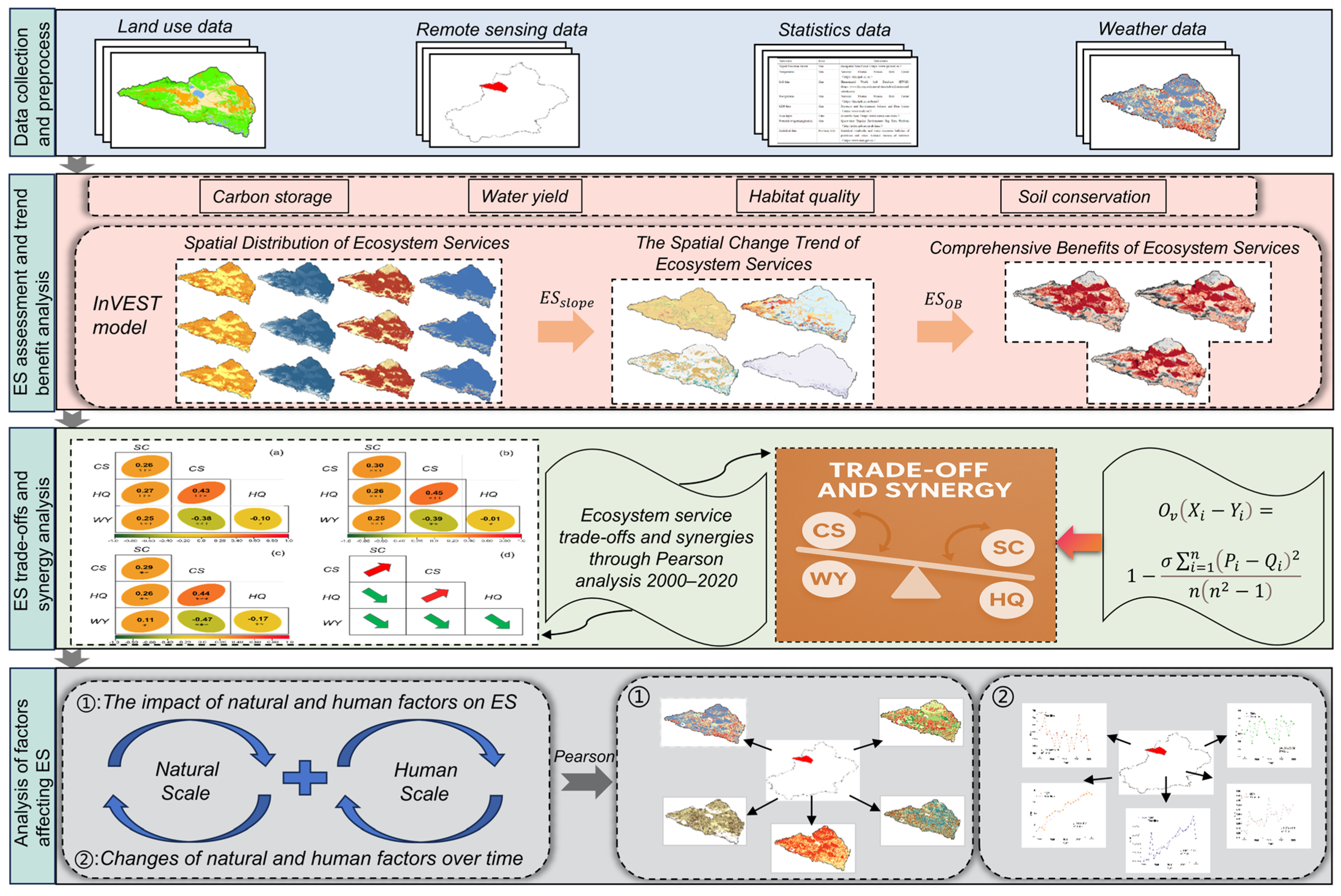

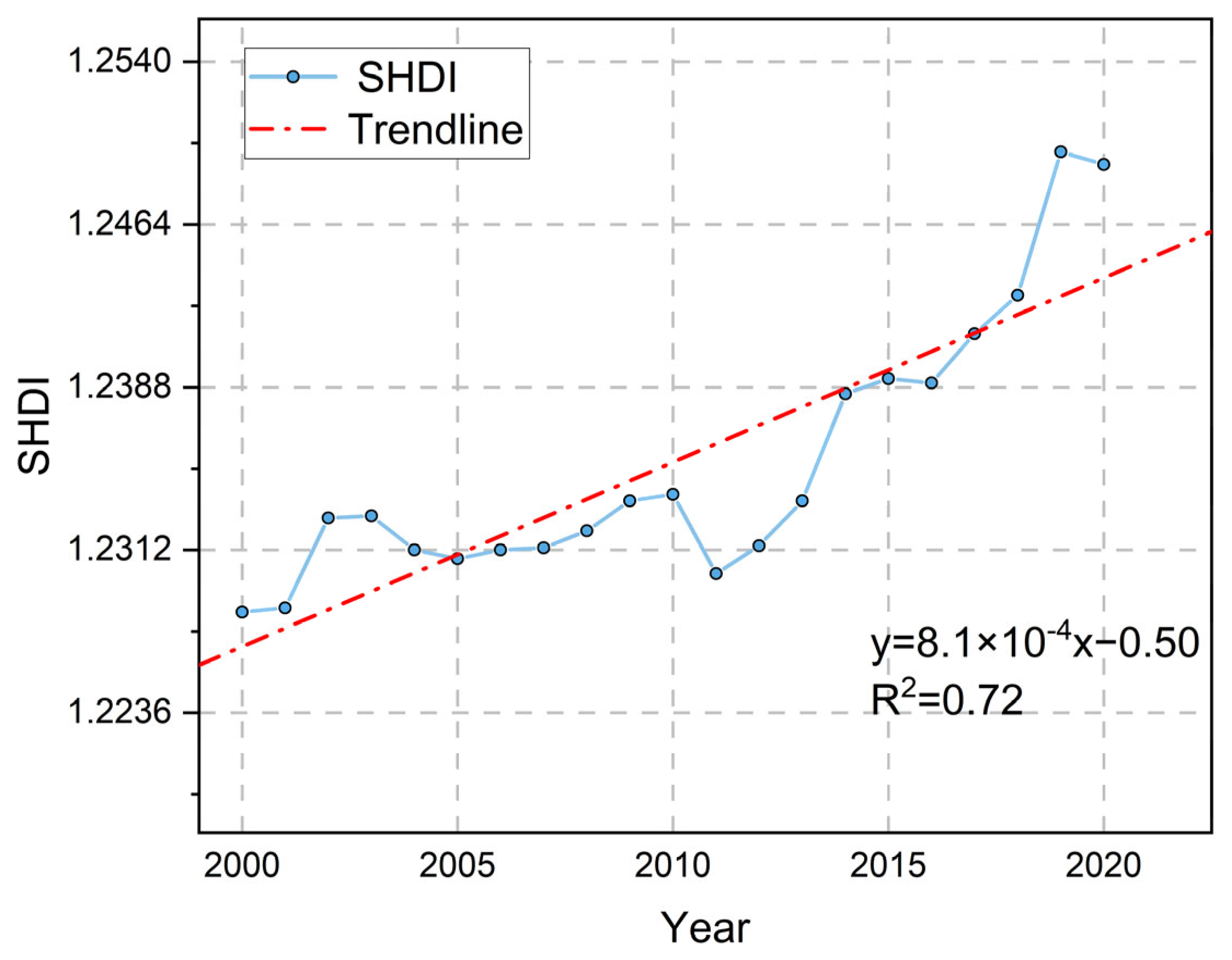
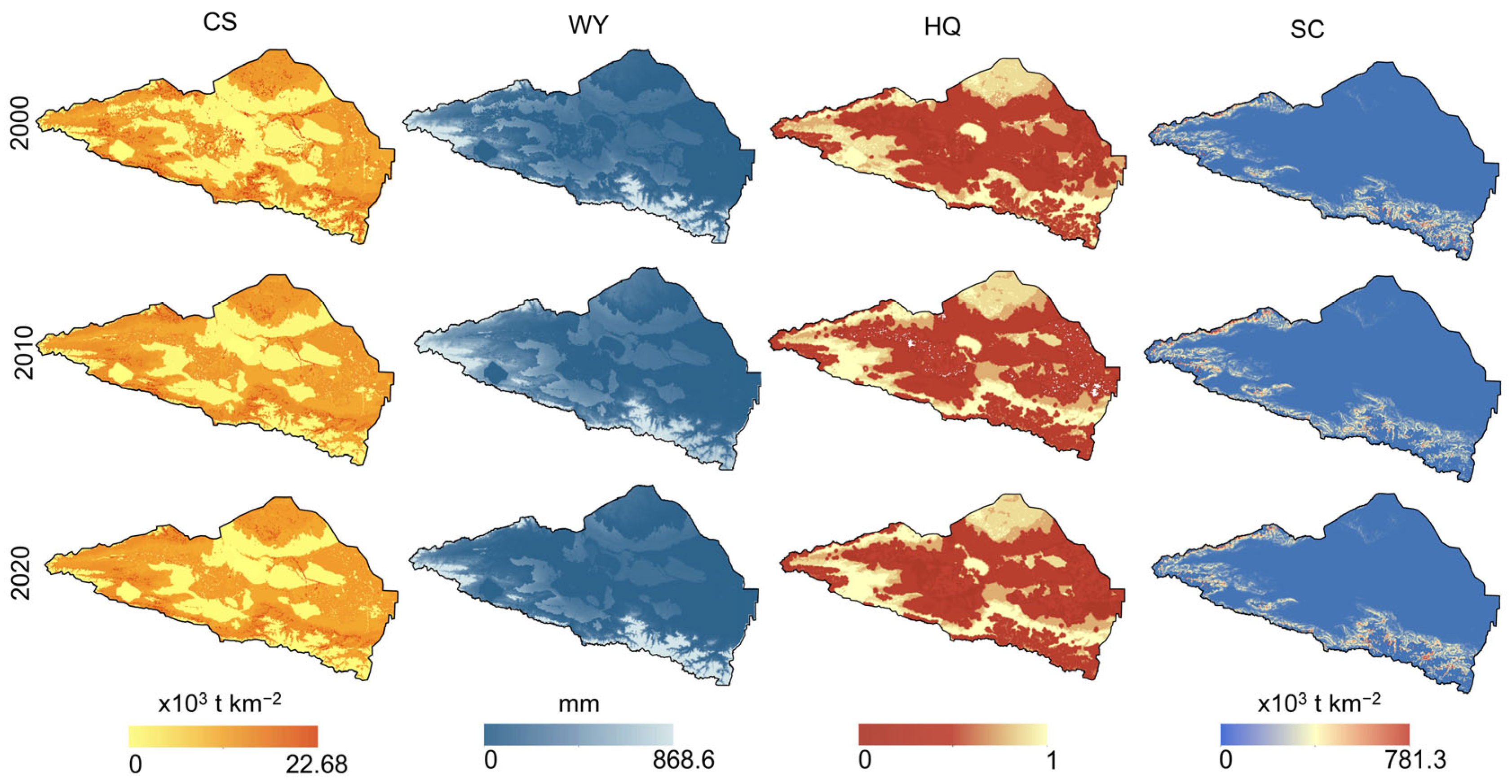


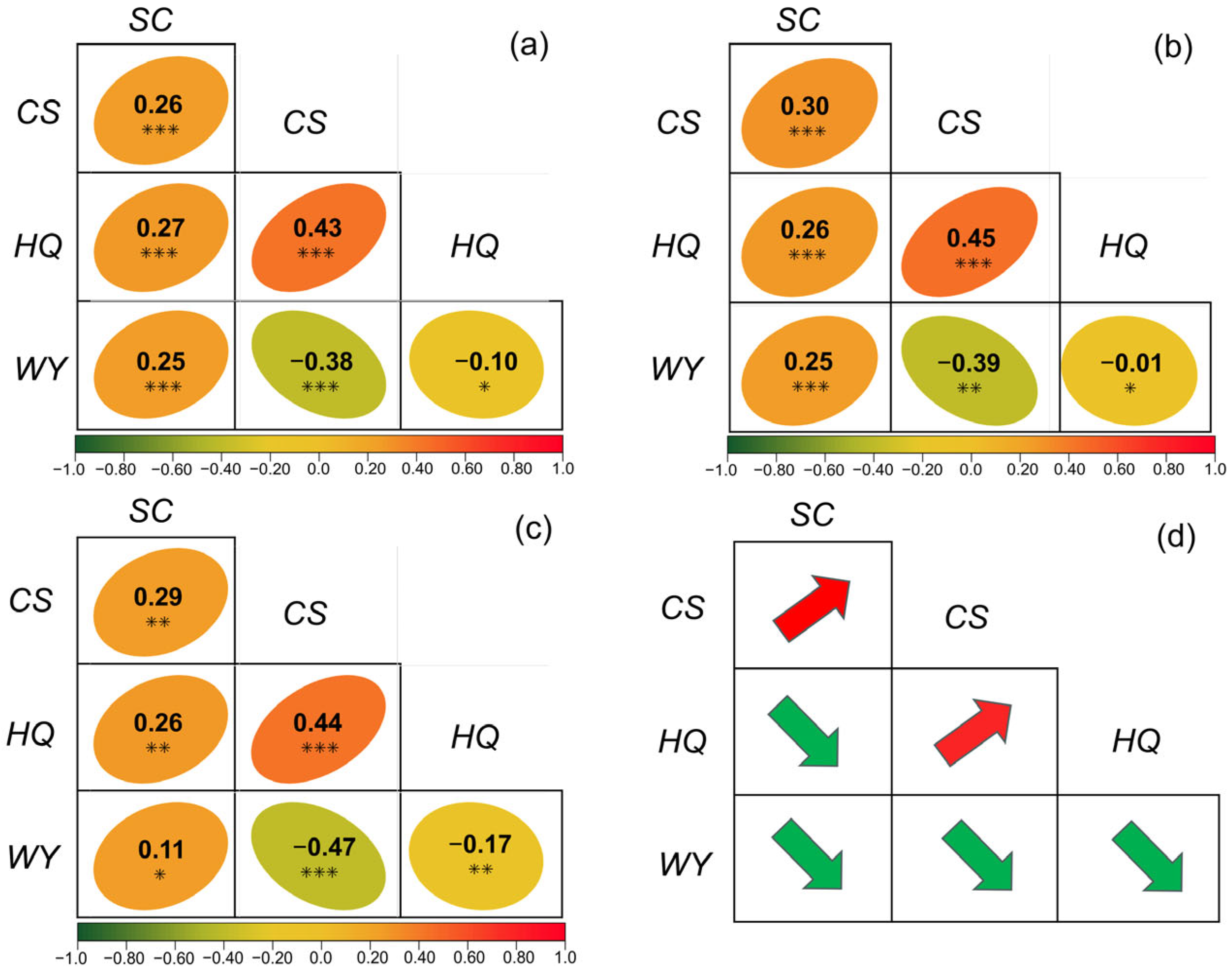

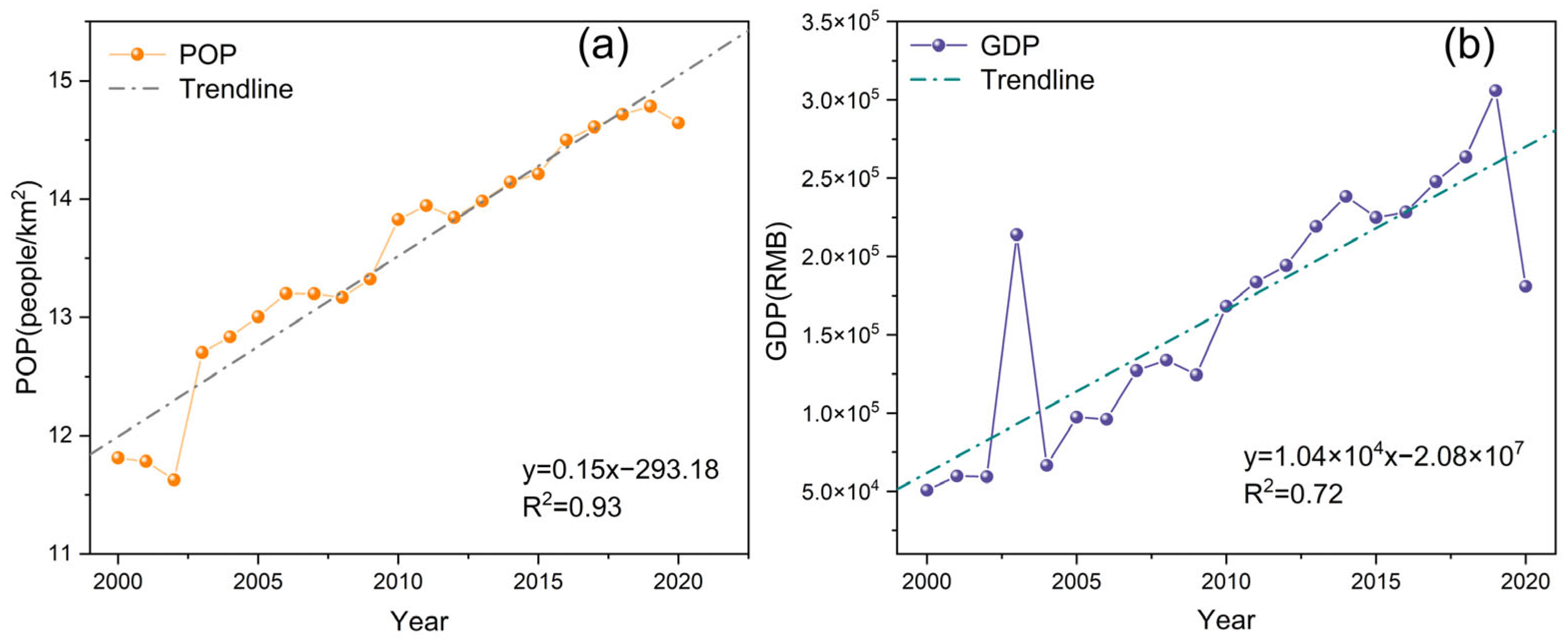


| Data Name | Spatial Scale | Time Scale | Data Source |
|---|---|---|---|
| Digital Elevation Model | 1 km | 2000–2020 | Geospatial Data Cloud (https://www.gscloud.cn/, accessed on 2 February 2025) |
| Land use type and NDVI | 1 km | 2000–2020 | Resource and Environment Science and Data Center (https://www.resdc.cn/, accessed on 2 February 2025) |
| Temperature | 1 km | 2000–2020 | National Tibetan Plateau Data Center (https://data.tpdc.ac.cn/, accessed on 8 February 2025) |
| Soil data | 1 km | 2000–2020 | Harmonized World Soil Database (HWSD) (https://www.fao.org/soils-portal/data-hub/soil-maps-and-databases/, accessed on 8 February 2025) |
| Precipitation | 1 km | 2000–2020 | National Tibetan Plateau Data Center (https://data.tpdc.ac.cn/home/, accessed on 8 February 2025) |
| GDP data | 1 km | 2000–2020 | Resource and Environment Science and Data Center (https://www.resdc.cn/, accessed on 10 February 2025) |
| Landscape Type | 2000 | 2010 | 2020 | |||
|---|---|---|---|---|---|---|
| NP | PD | NP | PD | NP | PD | |
| Farmland Landscape | 2048 | 0.0438 | 1828 | 0.0391 | 1868 | 0.0399 |
| Forest Landscape | 794 | 0.0170 | 763 | 0.0163 | 954 | 0.0204 |
| Grassland Landscape | 1700 | 0.0363 | 1594 | 0.0341 | 1648 | 0.0352 |
| Wetland Landscape | 13 | 0.0003 | 13 | 0.0003 | 15 | 0.0003 |
| Constructive Landscape | 8 | 0.0002 | 68 | 0.0015 | 253 | 0.0054 |
| Bare Landscape | 2710 | 0.0579 | 2693 | 0.0576 | 2647 | 0.0566 |
| Water Landscape | 412 | 0.0088 | 422 | 0.0090 | 444 | 0.0095 |
| Landscape Type | 2000 | 2010 | 2020 | |||
|---|---|---|---|---|---|---|
| LSI | PAFRAC | LSI | PAFRAC | LSI | PAFRAC | |
| Farmland Landscape | 40.9790 | 1.4630 | 36.3653 | 1.4726 | 37.8435 | 1.4708 |
| Forest Landscape | 37.4745 | 1.4930 | 36.5879 | 1.4934 | 41.0463 | 1.4936 |
| Grassland Landscape | 61.5392 | 1.4859 | 58.2641 | 1.4882 | 56.2352 | 1.4944 |
| Wetland Landscape | 5.0000 | 1.5421 | 5.0000 | 1.5421 | 5.0833 | 1.5565 |
| Constructive Landscape | 3.1778 | 1.0460 | 7.1296 | 1.2428 | 15.7835 | 1.3814 |
| Bare Landscape | 61.1496 | 1.4913 | 57.3669 | 1.4989 | 53.9501 | 1.4951 |
| Water Landscape | 21.8770 | 1.4246 | 21.8949 | 1.4221 | 22.2229 | 1.4130 |
| CS (102 t) | HQ | SC (103 t) | WY (mm) | |
|---|---|---|---|---|
| 2000 | 83.07 | 0.47 | 16.17 | 79.31 |
| 2010 | 89.21 | 0.48 | 19.87 | 115.99 |
| 2020 | 89.38 | 0.48 | 13.12 | 61.38 |
Disclaimer/Publisher’s Note: The statements, opinions and data contained in all publications are solely those of the individual author(s) and contributor(s) and not of MDPI and/or the editor(s). MDPI and/or the editor(s) disclaim responsibility for any injury to people or property resulting from any ideas, methods, instructions or products referred to in the content. |
© 2025 by the authors. Licensee MDPI, Basel, Switzerland. This article is an open access article distributed under the terms and conditions of the Creative Commons Attribution (CC BY) license (https://creativecommons.org/licenses/by/4.0/).
Share and Cite
Lv, G.; Wang, Y.; Ma, X.; Han, Y.; Luo, C.; Yu, W.; Liu, J.; Du, Z. Trade-Offs and Synergies of Ecosystem Services in Terminal Lake Basins of Arid Regions Under Environmental Change: A Case Study of the Ebinur Lake Basin. Land 2025, 14, 1240. https://doi.org/10.3390/land14061240
Lv G, Wang Y, Ma X, Han Y, Luo C, Yu W, Liu J, Du Z. Trade-Offs and Synergies of Ecosystem Services in Terminal Lake Basins of Arid Regions Under Environmental Change: A Case Study of the Ebinur Lake Basin. Land. 2025; 14(6):1240. https://doi.org/10.3390/land14061240
Chicago/Turabian StyleLv, Guoqing, Yonghui Wang, Xiaofei Ma, Yonglong Han, Chun Luo, Wei Yu, Jian Liu, and Zhiyang Du. 2025. "Trade-Offs and Synergies of Ecosystem Services in Terminal Lake Basins of Arid Regions Under Environmental Change: A Case Study of the Ebinur Lake Basin" Land 14, no. 6: 1240. https://doi.org/10.3390/land14061240
APA StyleLv, G., Wang, Y., Ma, X., Han, Y., Luo, C., Yu, W., Liu, J., & Du, Z. (2025). Trade-Offs and Synergies of Ecosystem Services in Terminal Lake Basins of Arid Regions Under Environmental Change: A Case Study of the Ebinur Lake Basin. Land, 14(6), 1240. https://doi.org/10.3390/land14061240








